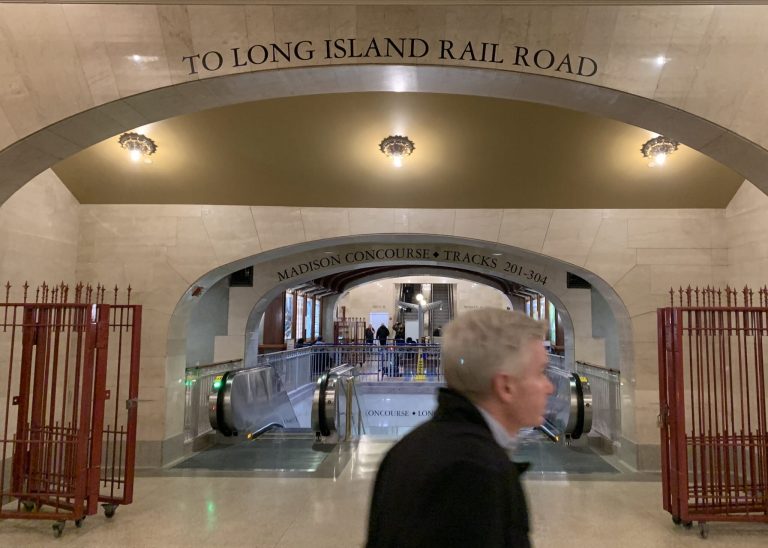
Metropolitan Transit Authority CEO Janno Lieber touted the implementation of LIRR service to Grand Central Madison during a Wednesday press conference, sharing the positive results of the newly established Eastside access.
But Port Washington residents say there are changes needed to fully serve their community and address the negative results of the schedule change.
During the press conference about “reimagining Grand Central,” Lieber said the opening of Grand Central Madison has led to a 40% increase in LIRR services due to increased tunnel capacity. This includes almost 300 LIRR trains running daily into Grand Central, Lieber said during the press conference.
He said the Grand Central Madison terminal and the broader efforts to revitalize the surrounding neighborhood through business growth and the expansion of public spaces are an attempt to draw people back into the city.
“It brings Long Island and the center of our business district closer together for so many people and that is in the long run going to have great benefits,” Lieber said.
Grand Central, which now houses the LIRR, Metro North and subway at a single station, began full service Feb. 27 with a changed schedule that added trains running into Grand Central to its regular Penn Station service.
Overall, fewer trains will be servicing Penn Station than before the new schedule.
While the LIRR now services Grand Central Station, the Gothamist reported that about 20% of THE LIRR trains cannot go through the East River Tunnel to the station, limiting the trains that can access the terminal. This is because the tunnel is too small for the MTA’s diesel trains.
Port Washington resident and local commuter activist Ian Rasmussen said there are many negative effects residents are experiencing due to the schedule changes.
“There’s no way around the fact that if you ask people in our town, ‘did you seriously consider the train service when you moved here?’ The answer would be universally ‘yes,’” Rasmussen said. “So an assault on the train service is really like an existential attack.”
Rasmussen, a commuter to Penn Station, said one of the issues is the number of evening train departures from Penn being cut in half.
During peak p.m. times, 10 trains depart from Penn Station, some with upwards of 45-minute gaps between trains.
One of the largest gaps between trains exists between the 5:10 departure and the 5:52 departure. Rasmussen said having a 42-minute-long wait time between trains, especially during a peak time when people are getting off work, can have great negative impacts.
He said that if you were to miss the 5:10 train, sometimes due to uncontrollable factors like a delayed subway, your arrival time in Port Washington is extended extraneously. He expressed concerns for people who have evening schedules to abide by, such as picking up a child from daycare, who then have to endure a long wait time for the next train and possibly be late to their next location.
Rasmussen said that prior to the current schedule, trains came about every 20 minutes.
“The trains out of Penn Station are absolutely packed, standing in the aisles,” Rasmussen said. “And the trains at Grand Central are half empty.”
Another issue that Rasmussen said was the original plan to exclude express trains. Due to efforts in September, in which Rasmussen was involved, local government officials were able to negotiate six express trains to run along the Port Washington branch, three in the morning and three in the evening.
Rasmussen said that prior to his advocacy for express LIRR services, he had never been involved with his local government. For the first time, he worked with his local state senator and assemblywoman to create a collection of government officials to push for their community’s needs.
“Your whole routine is largely informed by how you get around, particularly Long Island, which is essentially a satellite place to New York City,” Rasmussen said. “There needs to be a much more broad realization of the fact that schedules, decisions on where to live decisions on where to work, all of this is the result of sort of decades of living.”
Rasmussen added that friends of his who commute to Grand Central, previously commuting to Penn and then taking the subway, have sometimes experienced longer commute times.
He said another issue is that riders who want to transfer trains along their route have to wait sometimes 15 minutes for their connection, making commute times longer.
Rasmussen suggested that a solution to this would be to implement the original schedule of trains running to Penn Station and add additional trains running to Grand Central from Jamaica or Woodside.
The schedule implemented before the change on Feb. 27 was the reduced schedule in response to the pandemic and fewer people commuting into the city, and Rasmussen said that it worked well for people.
While Rasmussen said the LIRR schedule changes have posed problems for the community, he still thinks the Grand Central Madison terminal is a beneficial implementation. He said he doesn’t have an issue with the new terminal, but rather an issue with the schedule for the new terminal.






